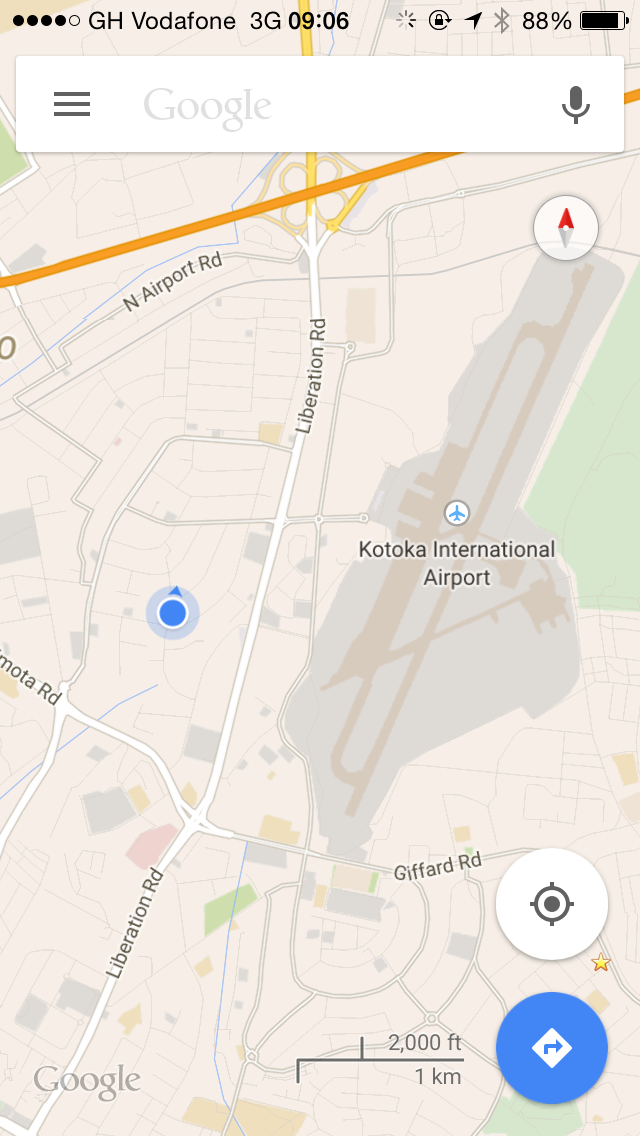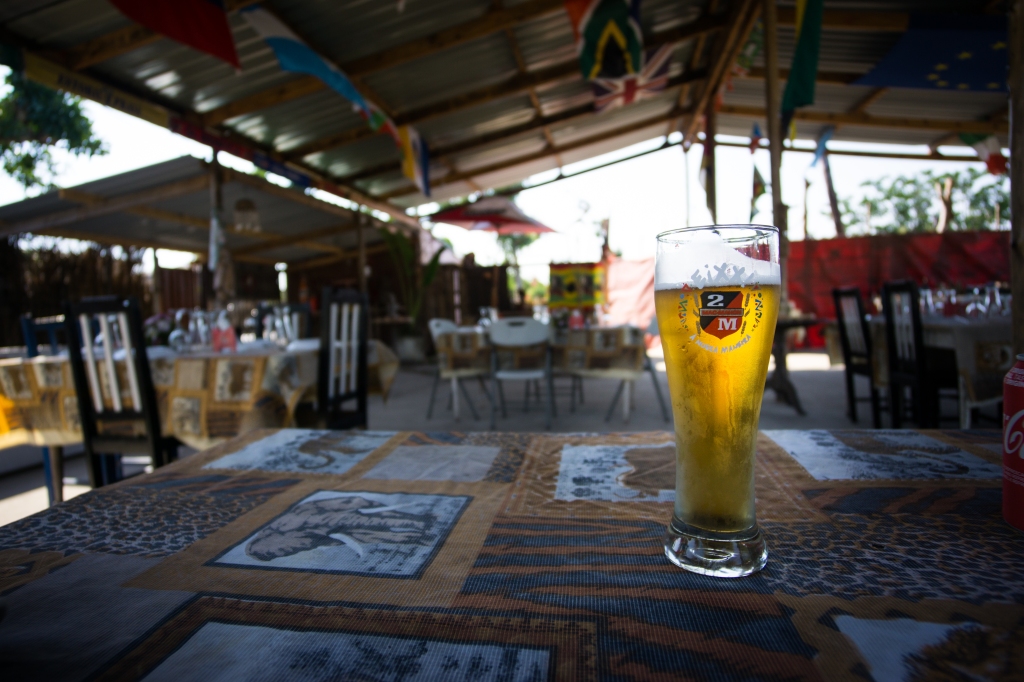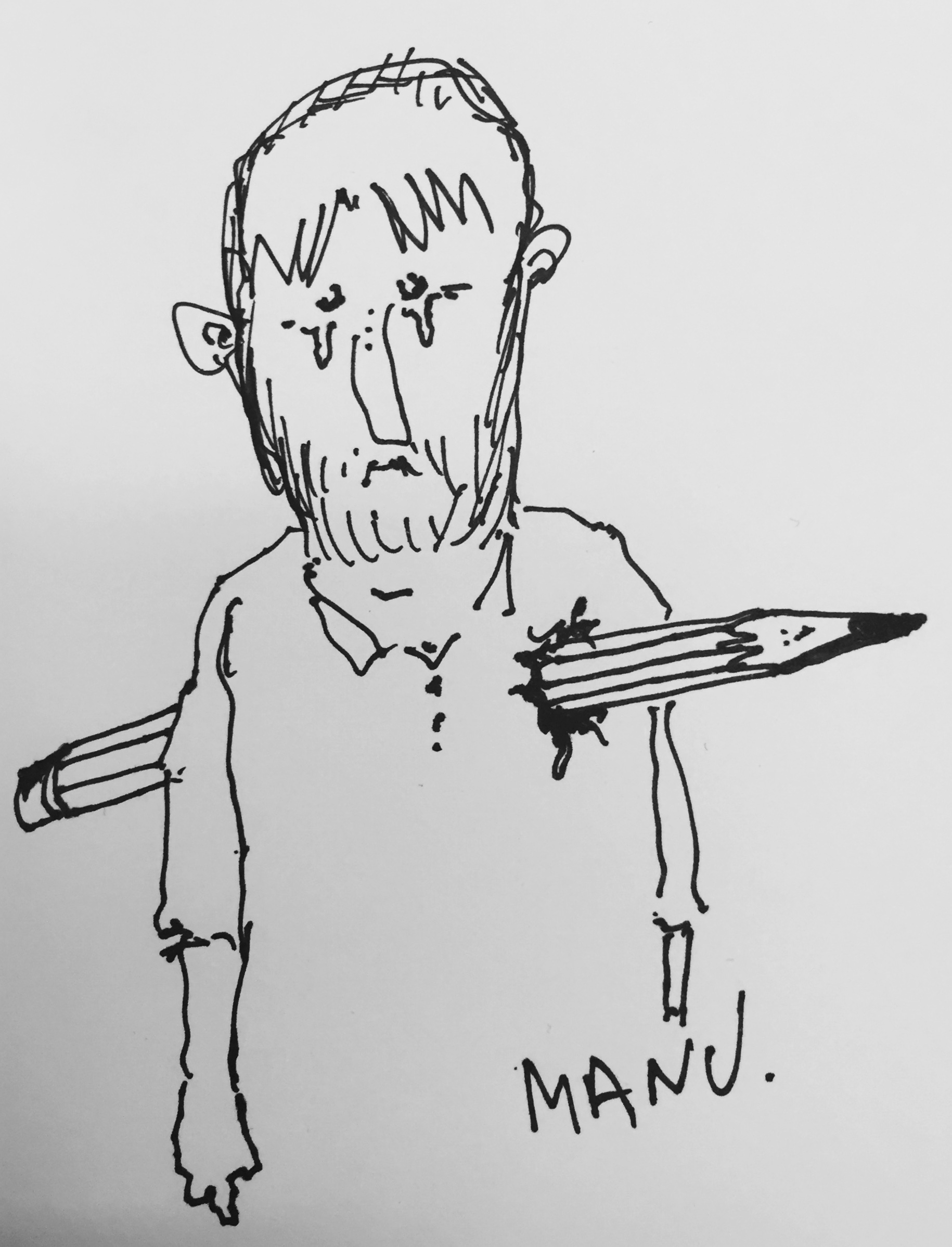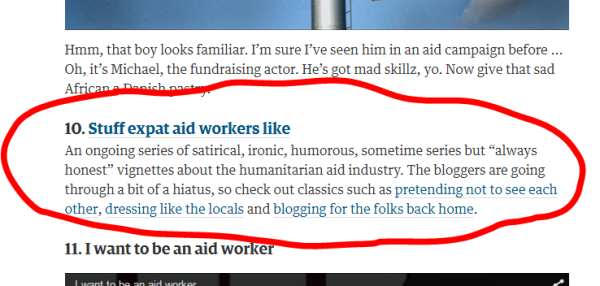#226 Tactical Gear
If there is one thing on which today’s Expat Aid Workers unanimously agree, it is the need to be and look ready for any environment. And by “any environment” we specifically mean the kinds of places where you can be hardcore, take selfies with war junk, and possibly even see burqas. In other words, large, complex humanitarian crises, where the possibility of having to actually run with your Quick Run Bag (QRB) is higher than in a “development context” of yesteryear.
Now of course many EAWs are famous for creating their own fashion. But in such environments (in the “Kevlar Belt”), it is critical that the EAW present him or herself in a way that says “put together, but prepared.” Because irrespective of whether or not things turn dark at that checkpoint just up ahead, no one wants to look like the weak link on the team.
Thankfully there is a line of apparel that can help even the least seasoned EAW look like the real deal: Tactical gear.

Image:https://images.app.goo.gl/45rywHAPSJ7RVR5z6
From rip-stop “Stryke” cargo pants, $300 boots (with paracord laces), an expandable system backpack, or a belt holster for your multi-tool and combat tourniquet, the possibilities for dressing and accessorizing with tactical gear are practically endless. These days there really is no excuse for even the gender advisor or the cash and voucher specialist to look any less badass than the field logistics manager.
And it doesn’t matter that you’re not currently in or on the periphery of a war zone. In Kinshasa, Managua, or even Bangkok, few things say “I’m a real humanitarian and I’m ready for anything” quite like some tastefully worn tactical gear.
Think twice about wearing tactical gear on home leave in the USA, though. You might be mistaken for a nut job conspiracy theorist, a member of the Oath Keepers, or a garden-variety insurrectionist-slash-militia member. You’ll also want to avoid arriving at an airport in the US wearing a Condor tactical hat in “desert sand” and carrying a passport full of stamps from countries that count as Deep Field, as this could lead to potentially awkward conversations with the FBI.
In any case, the days of stinky Chacos and goofy elephant print pants at coordination meetings are over. Get some tactical gear and look like you mean business.
#225 Toolkits
After a decade of research, monitoring and evaluation, and international conferencing, EAWs (and even some donors) have finally accepted that mobile apps are not a silver bullet that fixes deeply rooted issues in development and humanitarian contexts.
A good toolkit, though…. Now, that’s another story! Any complex issue can be easily broken down and resolved with a well-designed toolkit.
Men dominating the discussions at community meetings? Drop a gender toolkit with some best practices. Private sector tech partners contributing to genocide by weaponizing information? An advocacy toolkit on disinformation will help you convince big tech to change their business models. Child marriage on the rise due to natural disasters? Hire a human centered design firm, make a snazzy toolkit, and every family will understand the value of girls in time for the next big flood. Worried that your INGO might be racist? Use this year’s left over budget for a “decolonizing development” toolkit, and you’ll be on your way to a more equitable world.
When creating a toolkit, it is important that the content fit into a few pages. If not people will start asking for checklists (and everyone knows “we don’t want this to be a tick-box exercise”). At the same time, the toolkit must be detailed enough to cover every hypothetical situation that could ever come up for any team in any possible context. Otherwise the toolkit will not get good uptake. The best way to ensure you cover any possible situation is to make sure you have a robust review process, meaning one person from every team at your organization provides input into at least 5 drafts of the toolkit (a.k.a. “participation”). If you are creating a toolkit as part of a consortium or a working group (e.g., you are “coordinating”) this means having several people from each organization providing their feedback on all drafts.
Once your toolkit consultant has sorted through all the input (and you’ve had several meetings with key stakeholders to ensure that their advocacy and branding messages are worded correctly), you’ll need to create an acknowledgements page. Be sure to thank every EAW and INGO middle or upper management staff by name so that the toolkit has credibility. Don’t worry about naming local NGO staff or community members who provided most of the ideas and experiences and ‘good practices’ covered in the toolkit, as the toolkit is for their benefit, and their contribution is obviously part of your “localization” efforts (or something).
Also, make sure you add a disclaimer, noting that nothing in the toolkit represents the views of any of the organizations or donors involved and that any ideas in the toolkit are the sole responsibility of the consultant. Unless, of course, the toolkit is really good and starts to gain lots of traction. In that case, let it be known that the contents belong to the agency or donor that came into the consortium at the last minute and agreed to pay for the design (e.g., the one with the largest logo on the front cover).
A great thing about COVID-19 is that everyone everywhere is working from home. So there is no need to print your toolkit. This saves a lot of money. All toolkits can now be living documents, never printed, and endlessly iterated as jargon and proper wording shift over time. Thanks to Zoom, you can launch your toolkit online too, rather than having to organize a lot of in person workshops. This saves even more money and increases your reach. Do be sure to invite local staff and communities to the online toolkit launch and training so that they can build their capacity.
Toolkits are great. They can solve just about any problem in any context. They are one of the most versatile and scalable solutions in the aid world. If you really can’t figure out how to solve a problem, it’s probably because you haven’t invested sufficiently in toolkit development.
So get yourself a consultant, put together an advisory group, and get to work on developing a toolkit. You will be well on your way to changing even the most intransigent behaviors, addressing complex historical legacies, and shifting power dynamics that contribute to poverty and conflict.
#224 Deep Field
For as long as there have been Expat Aid Workers (EAWs), they have understood and expressed their own relevance in terms of location. It’s not about what you do; it’s all about where you do it. And before you get all indignant in the comments thread, think about how much meaning EAW derive from Bitching About HQ, Establishing Field Cred, or Blogging for the Folks Back Home, and how dependent all of those things are on distinctions between the field and, well, everywhere else.
But now that has-been celebs can start their own NGOs and random dudes can ride their motorcycles around Africa, the designation of the field has begun to lose its illusive luster. Now that you can get a Starbuck’s latte in Hanoi or Baku (fun fact: Starbuck’s is in more countries than IRC) the where of what we do as a defining element is now a matter of consternation, an issue in need of clarification.
Thanks in large part to EAW innovation and resilience, we have a new designation for those hardcore badasses who are really doing it: Deep Field. The basic formula is as follows:
- Nice places: HQ.
- Places not nice enough to be HQ: The field
- Really, really bad places: Deep field.
While of course the inter-agency standards for what counts as field versus deep field are still a matter of fierce debate (and lots of poseurs in places like Nairobi or Beirut try to front on social media like they’re in deep field), it usually comes down to things like Internet stability, weekend party options, or cheese in local supermarkets.
If you can read this, you’re not in deep field.
#223 Being Woke
If there is one thing that sets today’s Expat Aid Workers (EAW) apart from their counterparts of prior decades, it is that they are woke. Whereas 10 or 20 years ago a newb in this field needed to have read Roland Bunch, Linda Polman or Carlos Casteneda, today’s EAW reading list is more likely to include Ta-Nehisi Coates, Ibram X. Kendi, or, you know, Hugo Slim. It is important for EAWs to be aware of and in touch with real issues.
Why? Well, obviously because the EAW has a moral and ethical obligation to call out examples of non-woke-ness whenever those are encountered. Say the EAW has a mission to some pluralistic context where local colleagues of one ethnicity oppress colleagues of another ethnicity. It is up to the EAW to call that out.
It is on the EAW to use their privilege to point out the inherent racism in the locations and layout of Azraq or Dadaab, or the injustice of Trutier. It is the morally obligated duty of the woke EAW to bring local colleagues up-to-speed on the systemic oppression in South Sudan or Venezuela. It is incumbent on the thoughtfully woke EAW to help local colleagues understand the horrors of child marriage (Afghanistan, Yemen), the potential for exploitation built into beneficiary biometric data collection (too many places to mention), or the paradox being anti-the-authoritarian-Kurdish regime while being pro-separation (and calling the place “Kurdistan”). Super-woke EAWs can even help local colleagues begin to work on and overcome their own biases and prejudices and unpack their privilege.
The responsibilities of today’s EAW are heavy, indeed, but being woke is the first step toward illuminating injustices. And everyone knows you can’t fix a problem that you can’t see.
It is important to note that one of the rules of being a woke EAW is to let everyone around you know how woke you are. There are many ways to do this, but the most effective way is to engage in the most seriously earnest critique that you can possibly muster on every issue, in every situation. For maximum effect, earnest critique as a means of woke-signaling should be expressed by EAWs to their local colleagues. You need to let your local colleagues know just how deeply offended you are on their behalf, by whatever it is that those “other” expats did or said, or by whatever was deemed offensive. Centering the conversation on your own experiences and feelings about these issues does much to repair decades of harm.
Holding other EAWs to account for outdated views is usually counterproductive, but if you must do it righteous indignation is probably the best option. What you really want is for all the locals to think that you’re somehow different. And that difference is that you’re woke, or at least more woke than all the other EAWs. And you are willing to stand humbly and selflessly in the spotlight while leading the charge for change.
So put your local team to work churning out next year’s budget or this week’s 3Ws, and go Tweet about systemic oppression.
#222 Spreading Democracy
 As every EAW knows, democracy is the best form of government ever. And it only exists in the United States, Canada, and England. And some parts of the EU. (And possibly India and Costa Rica). A critical role of EAWs is helping spread democracy to the rest of the world, which doesn’t have it.
As every EAW knows, democracy is the best form of government ever. And it only exists in the United States, Canada, and England. And some parts of the EU. (And possibly India and Costa Rica). A critical role of EAWs is helping spread democracy to the rest of the world, which doesn’t have it.
This can be done in many ways. But the best results come when it is done via Democracy and Governance funding from countries that have true democracies (capitalist democracies, not social ones).
Democratic governance and human rights are critical components of sustainable development and lasting peace. Countries that have ineffective government institutions, rampant corruption and weak rule of law have a 30-to-45 percent higher risk of civil war and higher risk of extreme criminal violence than other developing countries.
There is so much that less developed countries can learn from long-standing democracies about the role of strong institutions for ensuring broad civic participation, transparency and accountability from elected officials, and smooth transitions of power. For example, protecting and promoting human rights, ensuring the possibility for free and fair elections, combating disinformation, strengthening digital safety for new and traditional media, and incorporating rule of law and justice, can be built right into human rights programming for surefire results.
With a few exceptions, EAWs are proud of their democracies and grateful that following their years of self-sacrifice and building up of their savings, they can return to their home countries (or one of the lesser democracies where the weather is better) to enjoy their waning years somewhere just, peaceful, and stable where all citizens can fulfill their potential.
Right up there with capacity building and stamping out corruption, spreading the cherished values of democracy is one of the best ways that EAWs can help the world become a better place.
ToonsEAWL: The end of 2020
#221 Embracing Change
It’s hard to believe that it’s been over 10 years since #stuffexpataidworkerslike emerged as a hashtag and we ran our first post here at Stuff Expat Aid Workers Like! And holy crap things have changed since then! The venerable Toyota Land Cruiser that gets us to our coordination meetings had a MSRP of around US $30,000 in 2010. In 2021 the base model lists for a cool US $85k and has a 9-inch touchscreen multi-media system (better than most team houses had in 2010).
Expat Aid Workers (EAWs) have seen so much change in the past decade, it’s a wonder they are still holding it together. The Joint Standards Initiative brought about the merger of the HAP and PIA which birthed CHSA (and just a few other acronyms). Whereas the Haiti earthquake was still a response in-progress in December of 2010, now it’s ancient history. Afghanistan, once foreboding and hardcore, is now just another humanitarian crossroads, a place to go when Juba has begun to lose its “deep field” appeal. Cambodia, formerly a field cred destination, is now an R&R destination. And amid all this disorienting change, EAWs have to manage the ongoing stress of wondering why the Sphere Project never endorsed the Joint Standards Initiative or the CHS…. Old timers can often be heard in fascinating discourse on this topic over beers at a corner table while newbies, back from CXB or NES, try to one-up each other with stories about Amouda and Erbil.
EAWs now have to deal with “The Nexus.” And gone are the days when the edgy EAW could make waves by suggesting cash transfer programming (CTP) might be better than in kind food and basic goods distribution. (It’s now called CVA and it comprises 18% of all humanitarian aid). Instead of easy debates on fuel-efficient stoves, the EAW must now be able to convincingly argue for or against the merits of blockchain, biometrics, and beneficiary data sharing.
In 2010, EAWs could follow Bill Easterly and Jeffrey Sachs for cutting edge aid system debates (or Dambisa Moyo if they were really cynical). Now Bill Easterly is in apparent Twitter retirement (as is the mythical Bill Westerly). Old guard humanitarian and development blogs like TexasinAfrica (last post: 2014) and Blood and Milk (last post: 2015) that ruled the humanitarian information superhighway now lie fallow. The Guardian’s corporatizing of the humanitarian blogosphere has fallen by the wayside.
In place of blogs, the savvy modern EAW keeps up to date via multiple humanitarian-themed Facebook groups and Instagram accounts. The Sachs-Easterly debate has been replaced by (mostly) friendly feuds between 50 Shades of Aid and Humanitarian Clusterposting (aka “Shaders” and “the HCP incels”). Humanitarian shitpost memes are now a thing. The Humanitarian Pup and Humanitarians of Tinder each have more followers than The New Humanitarian. And Aid Worker Jesus rules humanitarian twitter.
2016 sparked the subsequent trash-fires of Brexit, BoJo and Trump. Then in 2017 Alyssa Milano brought us the #metoo movement (hmmm, or was it Tarana Burke in 2006…?), shortly followed by the #aidtoo discussion. Not to mention the premier INGO safeguarding scandal brought to us by Oxfam in 2018.
2020, the year that changed everything (…yet changed nothing?) ushered in COVID-19, lockdowns, travel bans, and endless Zoom calls. Above all else, the inability to travel left many EAWs feeling that life may no longer be worth living.
2020 was also deeply marked by the murder of George Floyd, civil unrest, and widespread engagement in #blacklivesmatter. This gave humanitarian organizations a new opportunity to reassure their donors and the general public that they are serious about ending racism. For example, some agencies enhanced the diversity of their organizations by including local middle management and admin staff photos on the team page of their website — and alphabetizing them to avoid giving the impression that there is a hierarchy of power, with white EAWs at the top — before sending out their organizational statements in solidarity with the Black Lives Matter movement. Others worked hard to raise awareness and end racism with mandatory online training sessions and diversity committees led by the most vocal non-white staff member who needed an “expanded opportunity” to direct their energy into “something positive.”
While much has changed, some things remain constant, however. For example WFP’s food basket specifications have not changed since before this blog was launched. And the lowly Expat Aid Worker, despite being under severe stress due to travel bans and on-going, growing calls for localization, decolonization, and an overall reset, is nowhere near endangered.
Yes. EAWs are alive and well, still going to coordination meetings, still debating whether to take leave in Lisbon or back home in Little Rock, still collecting per diem when “on mission.”
So on or around the 10-year anniversary of SEAWL, a blog dedicated to poking fun at expat aid worker culture, we think it’s time for a reboot. The time is right to reopen the EAW conversation in this format. It seems we were mostly on the right track 10 years ago, and now it’s time to take our snarkastic (and we hope also thought-provoking) commentary to the next level. We’re planning a combination of brand-new material and remixes of some of the classics. We think you’ll love all of it!
As before, this will be a highly participatory endeavor, with the rules of engagement much the same as before, for those who are old enough to remember (and for those who aren’t or who for some other reason don’t remember or never knew, here are the rules of engagement).
Wherever you are, whether you’re stuck at HQ or in some deep-field duty station, whether you think of yourself as expat or a local or something else, we hope you’ll check in, have a good laugh, and maybe also think seriously about issues of inequity, sexism, racism, and white supremacy in the aid sector.
#220 Google Maps
 Submitted by Wayan Vota
Submitted by Wayan Vota
Back in the olden days, a freshly arrived expat aid worker was at the mercy of taxi drivers when navigating a city. Often lacking a detailed map or sense of local landmarks, the EAW would not know distances or even the right direction to his or her next meeting. Long, expensive drives were the usual result. Taxi drivers would act like they knew the location, but they were often just as lost as the EAW, yet unwilling to lose face or a fat fare.
Then came Google Maps on the mobile phone. Now the EAW knows as much, or sometime more, than the taxi driver. Expats can find their destination, track progress, and more often than not, direct the driver to the location.
All hail the power transfer from local to expat! May your next expat taxi ride be fast and direct.
A Moment of Silence
#219 Being Discovered
Although it may feel supremely un-aidworker-ish to admit it, one thing that most Expat Aid Workers have in common is that they want to be recognized for their contribution to the greater good. One can only make one’s living ensuring Sphere standards for the unfortunate and downtrodden for so long before the need for a bit of copious Facebook self-promotion takes over. Insisting on carrying one’s own luggage, or treating locals like peers, for example, are all great for making the point that one is all about solidarity with all things local/poor (or at least good at blending in). But for every EAW there eventually comes a point when they just want to be acknowledged. Preferably publicly.
Unfortunately, there really is no obviously right space for EAWs to assert themselves and take hold of this rightful recognition. Blogging is a go-to rookie move (any amateur can start a blog and front like they matter. Heck, any amateur can start their own NGO and go viral.) Some try to build an industry-wide reputation by being enigmatic (tough to make it work because everyone else is cynical, too, not to mention much too busy to be bothered knowing who’s who). Some go on a solitary quest to find themselves with the hopes of writing a best-selling novel memoir later, but that’s a long-shot (the best-selling part). Others simply make stuff up.
But none of that is exactly it. No, the prize that today’s self-aware EAW pines for is a serendipitous, unsought, nod of public acknowledgement — affirmation — by a prominent voice outside the aid world. To put it simply, EAWs want to be discovered.
While preferred discovery is that by a “mainstream” media outlet (or perhaps well-known journalist as a proxy), it is nevertheless of critical importance to understand that not all discovery is equal. There is a hierarchy of coveted discovery.
Here’s how it works:
- Discovery by an established publication is better than discovery by an individual journalist, unless the journalist is really famous.
- Discovery by a partially famous journalist who’s shtick is being critical of aid is better than discovery by a really famous journalist with a history of discovering things that turned out to be fraudulent.
- Discovery by an established dynastic publication is better than being discovered by the Huffington Post.
- Discovery by the Huffington Post is better than being pinged for discovery by Al Jazeera, only to be pulled later over a technicality (e.g., someone’s “rule” that you can’t be interviewed anonymously… true story).
- Discovery by the aid world journalism equivalent of pirate radio is better than discovery by a politically middle-of-the-road tabloid-gone-web-based and trying desperately to maintain an air of “liberal” and “non-corporate.”
- Unless of course we’re talking about that particular publication sometimes known as “an organ of the middle class” (there’s a mental image). In which case…
WOO-HOO!! WE’VE ARRIVED!!






